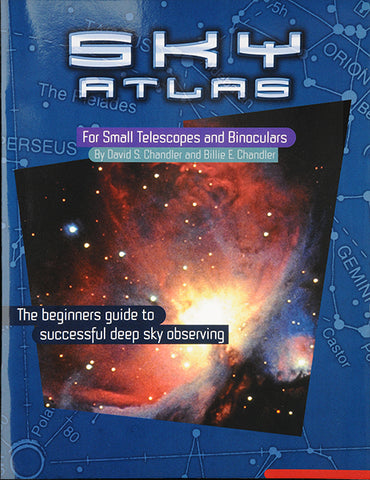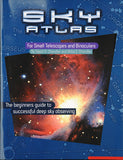Yes, our inventory is accurate!
![]() Qualifies Towards Free Ground Economy Shipping (CONUS Only) For Most Orders Of $79 Or More
Qualifies Towards Free Ground Economy Shipping (CONUS Only) For Most Orders Of $79 Or More
More 2.5″ (60mm) telescopes are sold each year than any other kind, but the instructions they come with explain how to assemble it and how to focus it, but little about what you can see with it! This is why you need a star atlas, but most atlases assume at least a 6″ or 8″ telescope and can be difficult for beginners to use.
This atlas is designed to help you enjoy the equipment you have, large or small and even binoculars, and really start enjoying the night sky.
If you own a small telescope already you should supplement it with a pair of binoculars, learn to use the equipment you have, and start spending time under the stars! Our Sky Atlas features nearly 200 deep sky objects selected for visibility in a 2.5″ telescope or simple binoculars.
The atlas format is similar to the classic Norton’s Star Atlas but presented in a simple and easy to use way. Think of an orange as the whole sphere of the sky. Slice off the two ends, then cut the remainder of the orange into six vertical slices. The first circular map covers the north polar region, six vertical segments spaced around the equator cover the majority of the sky, and the final circular map covers the south polar region. (The circular maps are stereographic projections and the vertical segment maps are transverse Mercator projections. Both projections preserve shapes well.) The maps highlight the Milky Way with representation digitized from a master Milky Way map by the renowned space artist, Don Davis. You will find this to be a great improvement over Milky Way outlines in most other atlases. Deep sky objects, including a careful selection of double stars and other stars of special interest, are highlighted in blue. Constellation figures are drawn to match the figures on our acclaimed planisphere, The Night Sky.
On the page facing each map are descriptions of the highlighted deep sky objects. They are grouped by constellation with catalog information and helpful commentary. Where more detail would be helpful, a small finder chart is included as an inset map. To be selected for our Sky Atlas, an object must be visible in a typical 2.5″ telescope, an ordinary pair of binoculars, or both. If you have a larger telescope this is still an excellent starter atlas. Many experienced observers find it useful as a guide to selecting bright objects for public star parties.
Some of the binocular objects we include are rarely marked on other atlases because they are too large for typical telescope fields of view. If you have another star atlas we challenge you to find a reference to Cr 70, the large but striking open cluster surrounding the three belt stars of Orion, Mel 20, the huge naked-eye cluster surrounding the brightest star in Perseus, Stock 2 or Mel 15 near the double cluster in Perseus, or Mel 111, the Coma Berenices cluster. These are all excellent binoculars objects that should not be overlooked, but typically are!
Preceding the atlas proper is a general overview of observing techniques, equipment, a little background on the nature of the deep sky objects to be observed, and suggestions on where to go next. The last page of the atlas is a list of resources including books, other charts, software, and periodicals.
Quoting from the text, “If this atlas does the job it is intended to do, you will soon outgrow it.” It is intended to ensure that your first steps in astronomical observing will be successful, exhilarating, and addictive.




